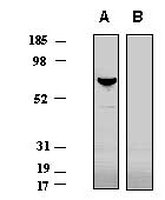PC376 Sigma-AldrichAnti-P2X4 Receptor (373-388) Rabbit pAb
Empfohlene Produkte
Übersicht
| Replacement Information |
|---|
Key Spec Table
| Species Reactivity | Host | Antibody Type |
|---|---|---|
| H, M, R | Rb | Polyclonal Antibody |
| Product Information | |
|---|---|
| Form | Liquid |
| Formulation | In 0.05 M sodium phosphate buffer, 0.2% gelatin. |
| Positive control | Mouse brain, rat brain, or SK-N-SH cells |
| Preservative | ≤0.1% sodium azide |
| Quality Level | MQ100 |
| Physicochemical Information |
|---|
| Dimensions |
|---|
| Materials Information |
|---|
| Toxicological Information |
|---|
| Safety Information according to GHS |
|---|
| Safety Information |
|---|
| Product Usage Statements |
|---|
| Storage and Shipping Information | |
|---|---|
| Ship Code | Blue Ice Only |
| Toxicity | Standard Handling |
| Storage | +2°C to +8°C |
| Do not freeze | Yes |
| Packaging Information |
|---|
| Transport Information |
|---|
| Supplemental Information |
|---|
| Specifications |
|---|
| Global Trade Item Number | |
|---|---|
| Bestellnummer | GTIN |
| PC376 | 0 |
Documentation
Anti-P2X4 Receptor (373-388) Rabbit pAb SDB
| Titel |
|---|
Anti-P2X4 Receptor (373-388) Rabbit pAb Analysenzertifikate
| Titel | Chargennummer |
|---|---|
| PC376 |
Literatur
| Übersicht |
|---|
| Le, K.-T., et al. 1998. Neuroscience 83, 177. Nicke, A., et al. 1998. EMBO J. 17, 3016. Ralevic, V. and Burnstock, G. 1998. Pharmcolol. Rev. 50, 413. North, R.A. and Barnard, E.A. 1997. Curr. Opin. Neurobiol. 7, 346. Radford, K.M., et al. 1997. J. Neurosci. 17, 6529. Buell, G., et al. 1996. EMBO J. 15, 55. Collo, G., et al. 1996. J. Neurosci. 16, 2495. Seguela, P., et al. 1996. J. Neurosci. 16, 448. Bo, X., et al. 1995. FEBS Lett. 375, 129. Lewis, C., et al. 1995. Nature 377, 432. |









